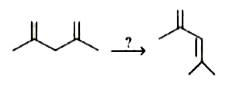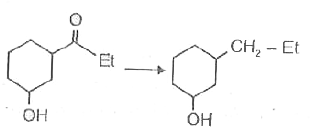Which of the following reagents would not be a good choice for reducing an aryl nitro compound to an amine?
H2(excess)/Pt
LiAlH6 in ether
Fe and HCl
Sn and HCl
The correct Answer is:B
To determine which reagent would not be a good choice for reducing an aryl nitro compound to an amine, we can analyze the given options step by step.
1. Identify the Aryl Nitro Compound:
- Let's consider nitrobenzene as our example of an aryl nitro compound. The structure of nitrobenzene is C6H5NO2, where the nitro group (-NO2) is attached to a benzene ring.
2. Evaluate the First Reagent (H2 with Pt):
- When nitrobenzene is treated with hydrogen gas (H2) in the presence of a platinum catalyst (Pt), the nitro group is reduced to an amine group (-NH2), resulting in aniline (C6H5NH2).
- Conclusion: This is a good choice for reduction.
3. Evaluate the Second Reagent (Fe and HCl):
- The combination of iron (Fe) and hydrochloric acid (HCl) is another common method for reducing nitro compounds. This reaction also converts nitrobenzene to aniline.
- Conclusion: This is also a good choice for reduction.
4. Evaluate the Third Reagent (Sn and HCl):
- Tin (Sn) in the presence of hydrochloric acid (HCl) similarly reduces nitrobenzene to aniline.
- Conclusion: This is a good choice for reduction as well.
5. Evaluate the Fourth Reagent (LiAlH4 in Ether):
- Lithium aluminum hydride (LiAlH4) is a very strong reducing agent. However, it does not effectively reduce aryl nitro compounds like nitrobenzene to amines. Instead, it can lead to side reactions or no reaction at all when applied to such compounds.
- Conclusion: This is not a good choice for reduction.
6. Final Answer:
- The reagent that would not be a good choice for reducing an aryl nitro compound to an amine is Lithium Aluminum Hydride (LiAlH4) in Ether.
- Let's consider nitrobenzene as our example of an aryl nitro compound. The structure of nitrobenzene is C6H5NO2, where the nitro group (-NO2) is attached to a benzene ring.
- When nitrobenzene is treated with hydrogen gas (H2) in the presence of a platinum catalyst (Pt), the nitro group is reduced to an amine group (-NH2), resulting in aniline (C6H5NH2).
- Conclusion: This is a good choice for reduction.
- The combination of iron (Fe) and hydrochloric acid (HCl) is another common method for reducing nitro compounds. This reaction also converts nitrobenzene to aniline.
- Conclusion: This is also a good choice for reduction.
- Tin (Sn) in the presence of hydrochloric acid (HCl) similarly reduces nitrobenzene to aniline.
- Conclusion: This is a good choice for reduction as well.
- Lithium aluminum hydride (LiAlH4) is a very strong reducing agent. However, it does not effectively reduce aryl nitro compounds like nitrobenzene to amines. Instead, it can lead to side reactions or no reaction at all when applied to such compounds.
- Conclusion: This is not a good choice for reduction.
- The reagent that would not be a good choice for reducing an aryl nitro compound to an amine is Lithium Aluminum Hydride (LiAlH4) in Ether.
Topper's Solved these Questions
- BOOK - NCERT EXEMPLAR ENGLISHCHAPTER - AMINESEXERCISE - SATQ37videos
AMINES
- BOOK - NCERT EXEMPLAR ENGLISHCHAPTER - AMINESEXERCISE - LONG ANSWER3videos
AMINES
- BOOK - NCERT EXEMPLAR ENGLISHCHAPTER - ALDEHYDE, KETONES AND CARBOXYLIC ACIDSEXERCISE - Long Answer Type Questions4videos
ALDEHYDE, KETONES AND CARBOXYLIC ACIDS
- BOOK - NCERT EXEMPLAR ENGLISHCHAPTER - BIOMOLECULES EXERCISE - Long Answer Type Questions5videos
BIOMOLECULES
Similar Questions
Knowledge Check
- Question 1 - Select One

Which of the following reagents will not react with above compound ?ANa metalBAgNO3+NH4OHCCu2Cl2+NH4OHDNaHCO3 - Question 2 - Select One or More
Which of the following reagents would convert an aldose into corresponding aldonic acid?
ATollen's reagentBFehling's solutionCBromine waterDRed P+HI - Question 3 - Select One
Which of the following reagents would best accomplish the following transformations?
 AExcess B2H6,NaOH/H2O2 followed by OsO4BExcess Hg(OAc)2/H2O,NaBH4ΘOH followed by H2SO4,ΔCO3,Zn/H2O followed by Hg(OAc)2/H2O,NaBH4,ΘOHDOsO4,NaHSO3 followed by NaOH
AExcess B2H6,NaOH/H2O2 followed by OsO4BExcess Hg(OAc)2/H2O,NaBH4ΘOH followed by H2SO4,ΔCO3,Zn/H2O followed by Hg(OAc)2/H2O,NaBH4,ΘOHDOsO4,NaHSO3 followed by NaOH


